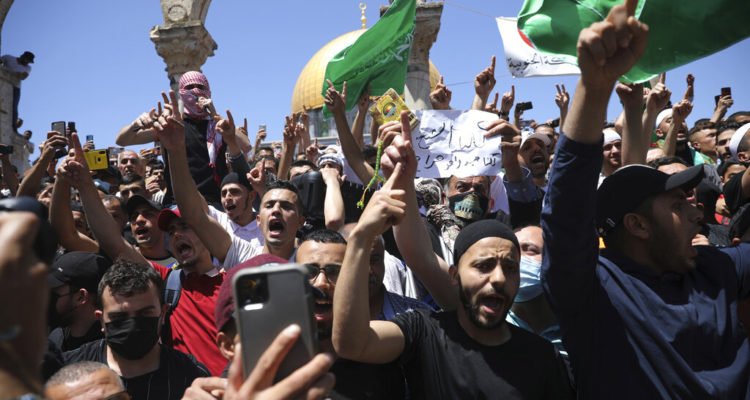While even Palestinian officials agree that Iranian-backed Hamas now controls the Temple Mount, most media have failed to report on the mullahs’ role in inciting the violence in Jerusalem.
By Akiva Van Koningsveld, HonestReporting
Are global media outlets complicit in obfuscating the true root causes of ongoing unrest at holy sites in Jerusalem?
Indeed, news organizations are repeating the same mistakes they made ahead of the May 2021 Hamas-initiated conflict with Israel, by failing to connect the dots between Palestinian violence and Iran’s destabilizing efforts in the region.
On April 15, 2022, just hours after Hamas supporters launched yet another premeditated assault against Israeli security forces atop the Temple Mount, Iranian Foreign Minister Hossein Amir-Abdollahian phoned the Palestinian terror group’s political leader.
During the conversation, Tehran’s top diplomat reportedly hailed Hamas-promoted chaos inside and outside Al-Aqsa Mosque as “the resistance of the heroic and brave people of Palestine.”
For his part, Hamas chief Ismail Haniyeh thanked Amir-Abdollahian for the Islamic Republic’s “support of the holy cause of liberating Palestine and the holy city of al-Quds [Jerusalem in Arabic].” A day earlier, Iranian leader Ali Khamenei published the recording of a speech in which he praised Palestinian rioters.
Meanwhile, a top Palestinian cleric who preaches at Al-Aqsa this week attended a virtual conference alongside the leaders of Hamas, Hezbollah, and Palestinian Islamic Jihad (PIJ), all U.S.-designated terrorist organizations that receive substantial support from Iran.
In their video addresses, the terror commanders warned that tensions in Jerusalem could spark a “regional conflict” involving Iran and its proxies.
Yet while analysts and even Palestinian officials agree that Iranian-backed Hamas — and not Jordan or the Palestinian Authority — now controls the Temple Mount, where the Al-Aqsa Mosque complex is located, most media have failed to report on the mullahs’ role in inciting the violence in Jerusalem.
‘The First Issue of the Muslim World’
This comes despite the security situation in Israel quickly deteriorating last year on May 7, when Palestinians marked Quds Day. Held annually on the final Friday of Ramadan, it was launched in 1979 by then-Iranian leader Ruhollah Khomeini in protest of the Jewish state’s existence.
On every Quds Day since, Iranian officials have reiterated the Islamic Republic’s commitment to “erasing the Zionist regime” by way of its terror proxies. To achieve this goal, Iran provides Hamas, PIJ, and other Palestinian terrorist groups with funds, weapons, and military training.
Ayatollah Ahmad Jannati, Secretary of Iran’s Guardian Council, recently explained that Quds Day also serves to “intensify global hatred” of the “occupying Zionist regime.” In fact, municipal officials in Berlin in 2021 banned the Quds Day march due to the violent and antisemitic nature of the event; Jewish organizations have called on London to follow suit.
This year, Quds Day fell on Friday, April 29. In anticipation, Tehran launched a social media campaign with the slogan, “Palestine, the first issue of the Muslim world.”
The accompanying hashtag, #Quds_Main_Issue, was shared some 1,500 times by Iranian regime-linked Twitter accounts in a matter of days. Materials distributed by Iran’s Foreign Ministry advocated for the “illegitimate Zionist regime [to] be declared terminated” by terrorist groups that operate under the banner of Iran’s “Axis of Resistance.”
‘The Preparations for Conflict Against Israel are Constant’
Iran’s influence also seeps into the rhetoric routinely utilized by Hamas, the self-designated “defender of Jerusalem and the Islamic holy sites:”
On April 26, Ekrima Sabri, the former grand mufti of Jerusalem, attended an online summit marking Quds Day. Speakers included Hezbollah’s Hassan Nasrallah, Hamas’ Ismail Haniyeh, and PIJ’s Ziyad al-Nakhala — as well as the archbishop of the Greek Orthodox Church in Jerusalem.
“The [Islamic] nation is obligated to defend the residents of Jerusalem,” Sabri told the Iranian-sponsored conference. Notably, Sabri’s successor as grand mufti was expelled from the Al-Aqsa Mosque in May 2021 after he refused to support Hamas in his sermon.
Nasrallah added: “Jerusalem has an Axis that creates a strong, solid regional equation to protect and liberate [it].” A representative of the Yemen-based Houthi rebels expressed a similar sentiment, stating that “any existential threat to Al-Quds means a regional war,” and that the Iran-backed Houthis “would not hesitate to participate” with “our brothers in the Axis of resistance and jihad.”
PIJ head al-Nakhala was equally clear: “Iran too stands by Palestine’s liberation with all its might and commitment,” he noted.
The next day, Iranian state media reported that a Hamas delegation arrived in Tehran. The IRNA piece said the group, led by Khalil al-Hayya, would attend a meeting on April 28 in order to discuss “the latest status of the Palestinian nation’s resistance.”
Not to be outdone, additional Palestinian terror groups that receive Iranian backing, including the Popular Front for the Liberation of Palestine (PFLP) and the Popular Resistance Committees, have called for more violence at Quds Day events being held in the Gaza Strip.
Iran’s hand in sowing unrest in Jerusalem and beyond is clearly visible. Yet, during an April 20 interview with Israeli Prime Minister Naftali Bennett, CNN anchor Christiane Amanpour accused Israel of creating “a lot of tension” by attempting to quell the violence at Jerusalem’s holiest site.
As analyst Jonathan Schanzer noted in his book “Gaza Conflict 2021,” “the preparations for conflict against Israel are constant, and usually with help from state sponsors. There is rarely one single spark that ignites a conflict. There is no single point of failure — except, perhaps, in the reporting that follows.”
